Co‑culture of hepatocellular carcinoma cells and human umbilical endothelial cells damaged by SU11274
- Authors:
- Minoru Tomizawa
- Fuminobu Shinozaki
- Yasufumi Motoyoshi
- Takao Sugiyama
- Shigenori Yamamoto
- Naoki Ishige
View Affiliations
Affiliations: Department of Gastroenterology, National Hospital Organization Shimoshizu Hospital, Yotsukaido, Chiba 284‑0003, Japan, Department of Radiology, National Hospital Organization Shimoshizu Hospital, Yotsukaido, Chiba 284‑0003, Japan, Department of Neurology, National Hospital Organization Shimoshizu Hospital, Yotsukaido, Chiba 284‑0003, Japan, Department of Rheumatology, National Hospital Organization Shimoshizu Hospital, Yotsukaido, Chiba 284‑0003, Japan, Department of Pediatrics, National Hospital Organization Shimoshizu Hospital, Yotsukaido, Chiba 284‑0003, Japan, Department of Neurosurgery, National Hospital Organization Shimoshizu Hospital, Yotsukaido, Chiba 284‑0003, Japan
- Published online on: September 10, 2014 https://doi.org/10.3892/br.2014.361
-
Pages:
799-803
Metrics: Total
Views: 0 (Spandidos Publications: | PMC Statistics: )
Metrics: Total PDF Downloads: 0 (Spandidos Publications: | PMC Statistics: )
This article is mentioned in:
Abstract
Mesenchymal‑epithelial transition factor (c‑Met) is a receptor that binds to the hepatocyte growth factor and is upregulated in hepatocellular carcinoma (HCC). The anti‑tumor effects of (3Z)‑N‑(3‑chlorophenyl)‑3‑({3,5‑dimethyl‑4‑[(4‑methyl-piperazin‑1‑yl)carbonyl]‑1H‑pyrrol‑2‑yl}methylene)‑N‑me-thyl‑2‑oxo‑2,3‑dihydro‑1H‑indole‑5‑sulfonamide (SU11274), a c‑Met inhibitor, were investigated in the present study. HCC cells (HLE, HLF, PLC/PRL/5, Hep3B, Huh‑6 and HepG2) and human umbilical vein endothelial cells (HUVECs) were used. Quantitative polymerase chain reaction was performed to detect the expression level of c‑Met in HCC and HUVECs, and cyclin D1 in HCC. The 3‑(4,5‑dimethylthiazol‑2‑yl)‑5‑(3‑car-boxymethoxyphenyl)‑2‑(4‑sulfophenyl)‑2H‑tetrazolium inner salt assay was performed to assess the proliferation of the HCC cells and HUVECs cultured with SU11274. Co‑culture of HLF or PLC/PRL/5 cells and HUVECs was established as an in vitro model of HCC tissues. The expression levels of c‑Met in HLE, HLF, PLC/PRL/5, Hep3B, Huh‑6 and HepG2, adult healthy liver and HUVECs were 4.43±0.50, 1.61±0.18, 3.70±0.08, 0.81±0.18, 6.60±1.29, 1.06±0.35, 1.00±0.09 and 88.8±17.3 (mean ± standard deviation), respectively. SU11274 (30 µM) suppressed the proliferation of HLF, PLC/PRL/5 and HUVECs to 11.0±9.4, 46.5±30.7 and 29.4±5.0%, respectively. SU11274 (30 µM) decreased the expression levels of cyclin D1 in HLF and PLC/PRL/5 cells to 45.1±11.6 and 30.1±10.3%, respectively. SU11274, at a concentration of 30 µM damaged the morphology of the co‑cultures of HLF or PLC/PRL/5 cells with HUVECs and all the cells died. c‑Met is highly expressed in HUVECs and HCC cells, but not in Hep3B. At a 30‑µM concentration, SU11274 suppresses the proliferation of HLF, PLC/PRL/5 and HUVECs. SU11274 (30 µM) damages the co‑cultures of HLF or PLC/PRL/5 cells with HUVECs.
View Figures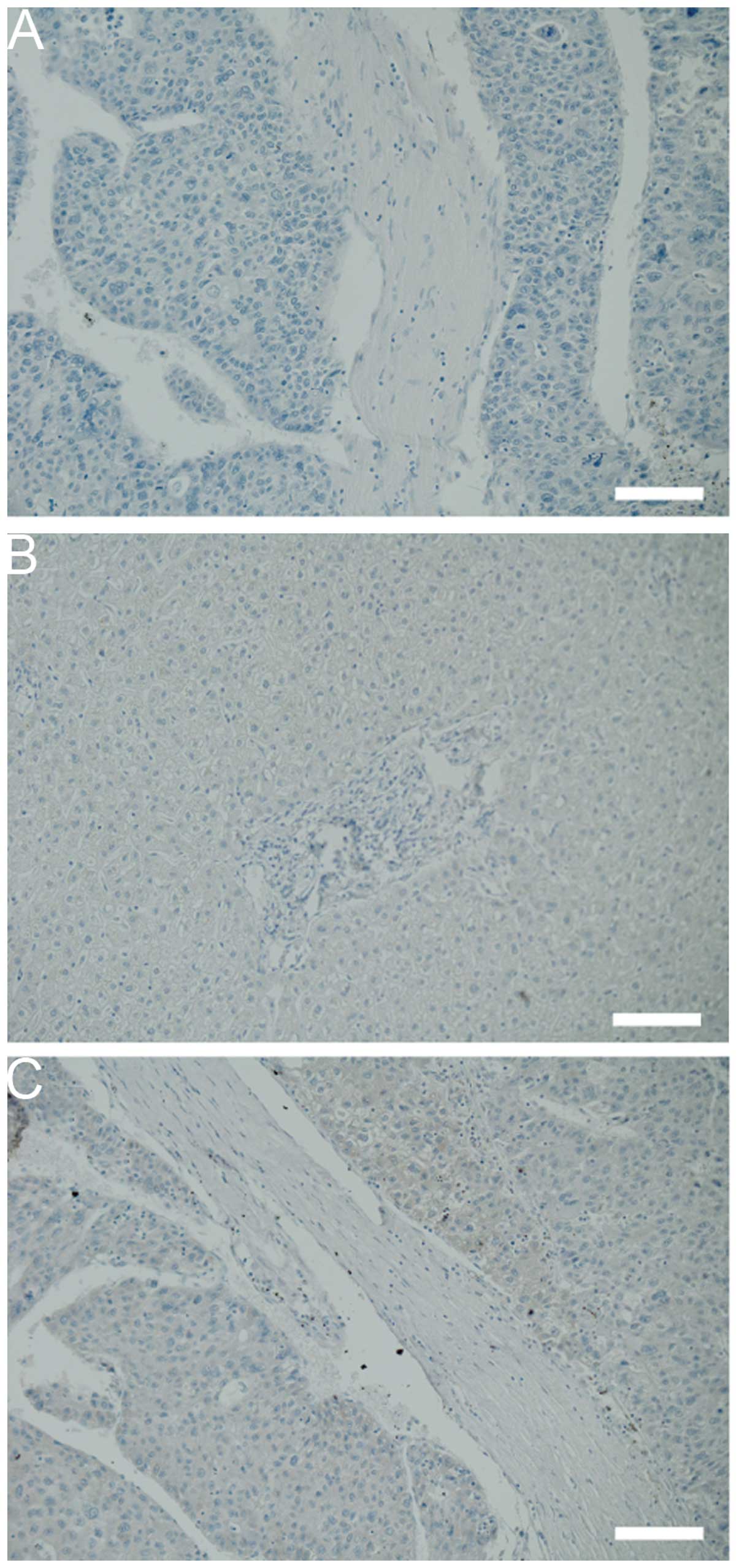 |
Figure 1
|
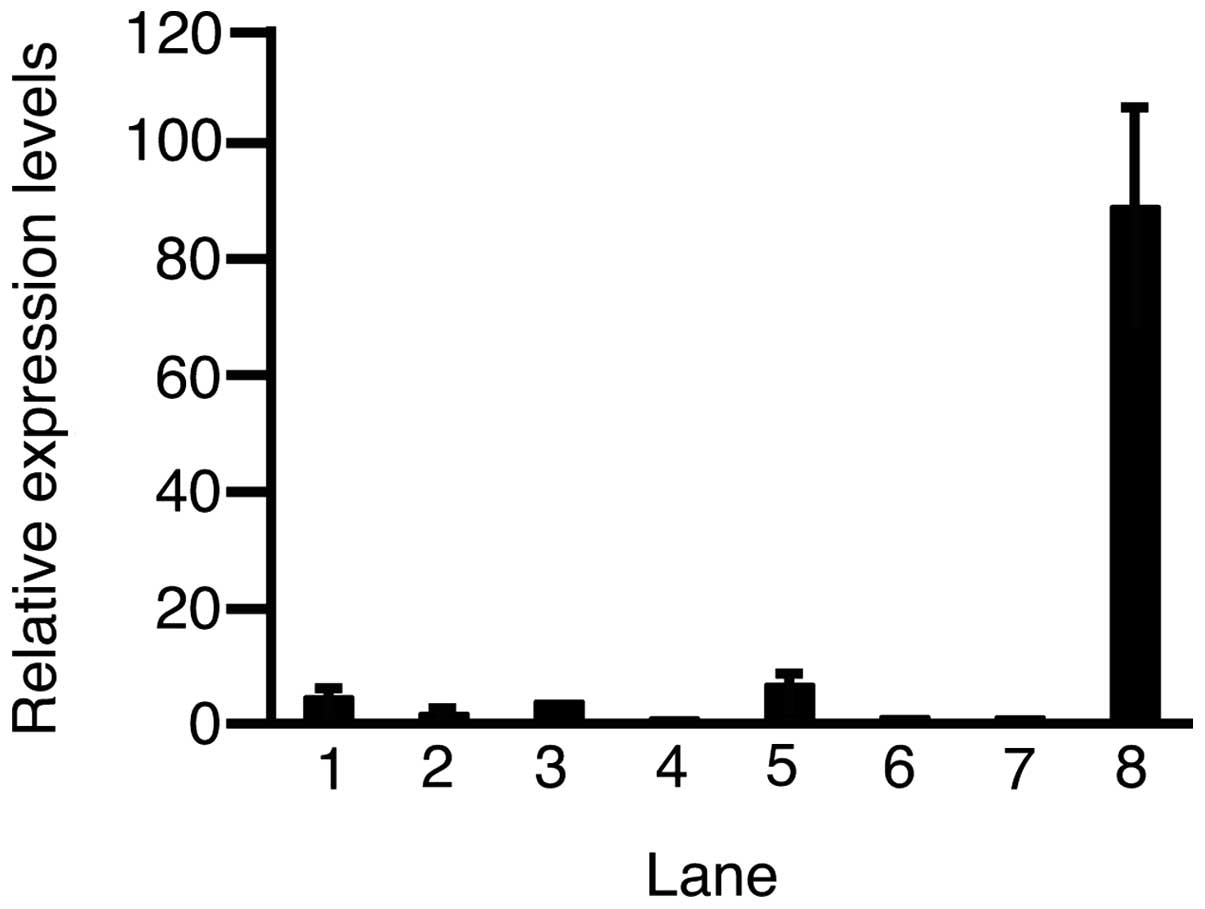 |
Figure 2
|
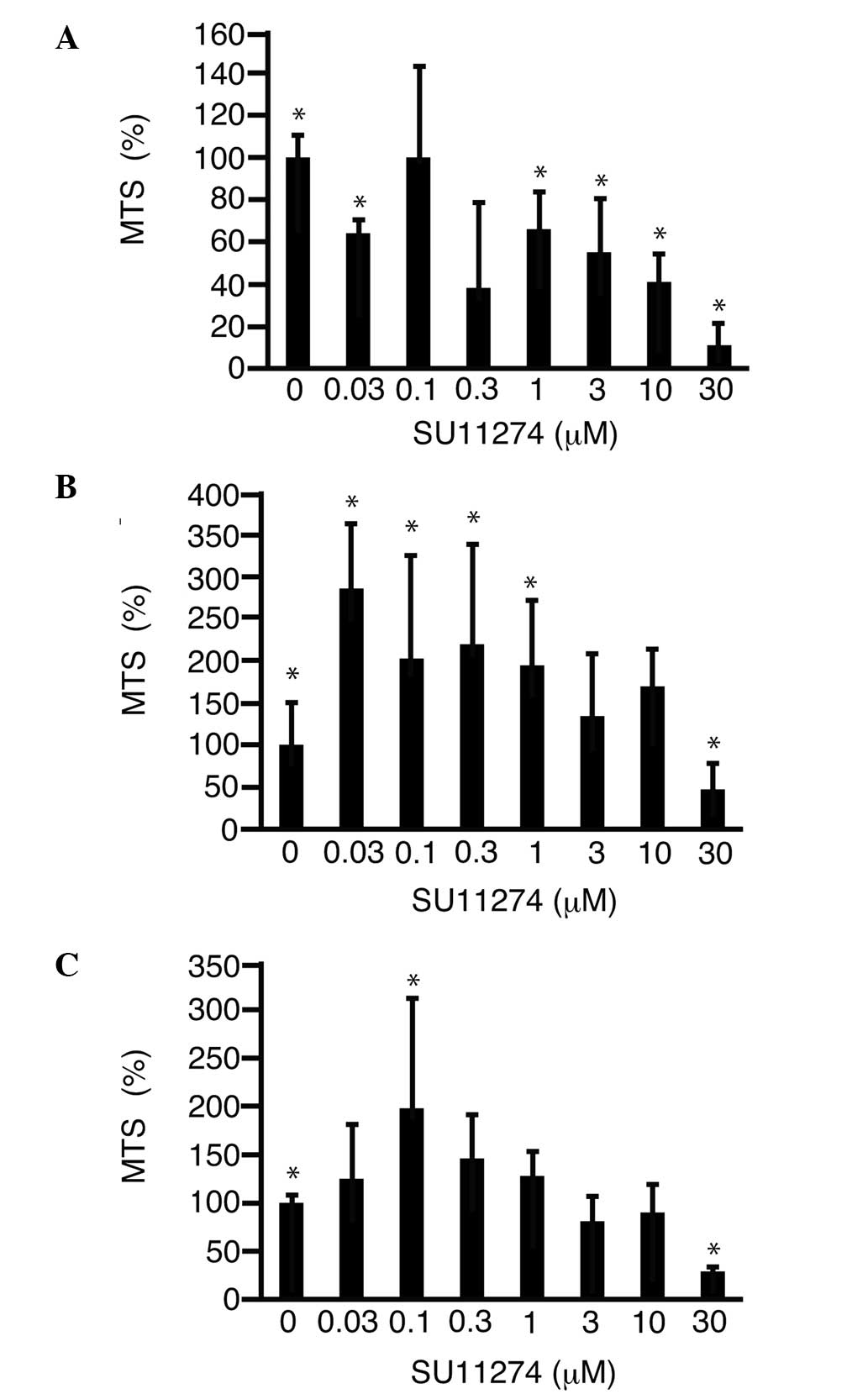 |
Figure 3
|
 |
Figure 4
|
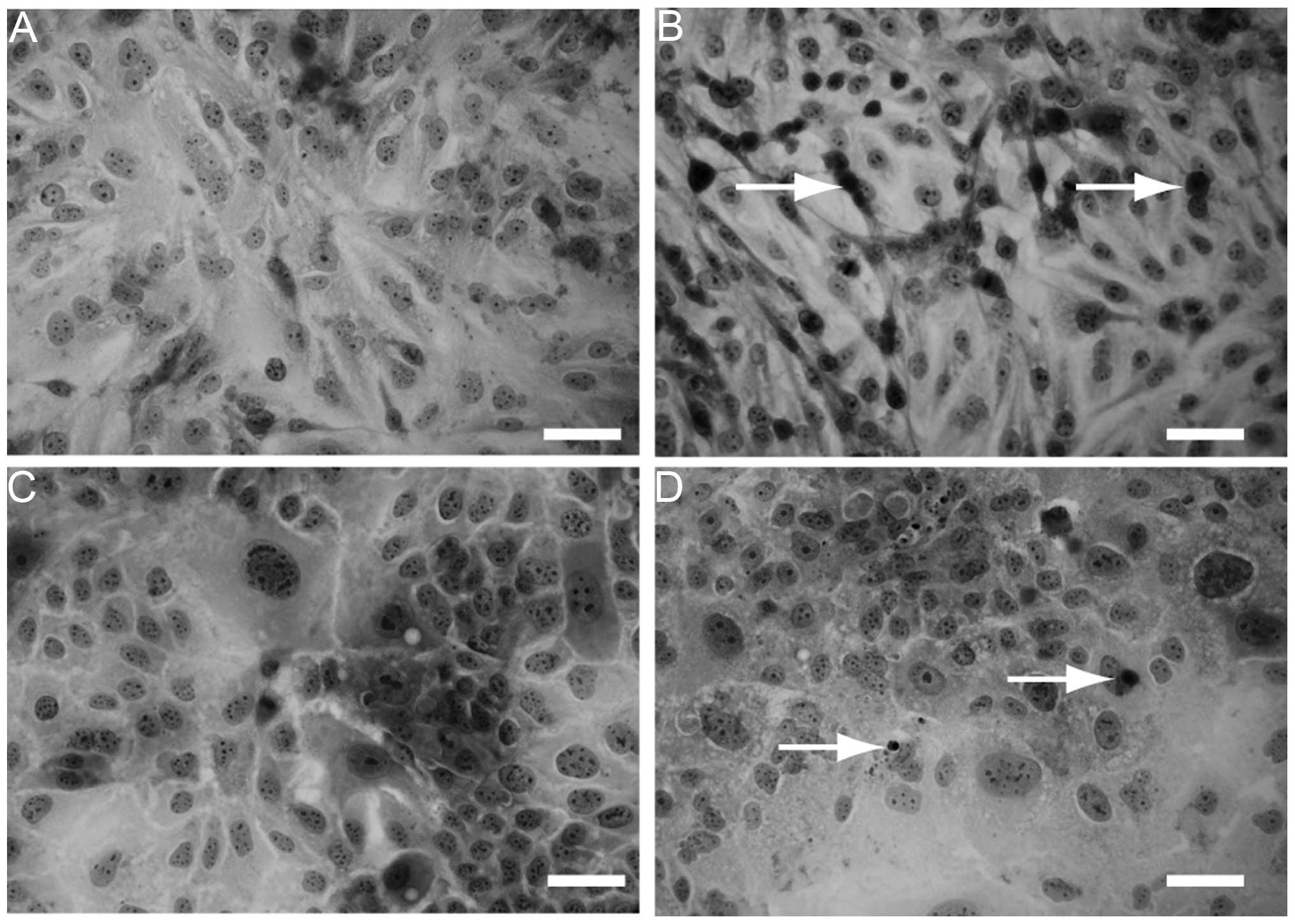 |
Figure 5
|
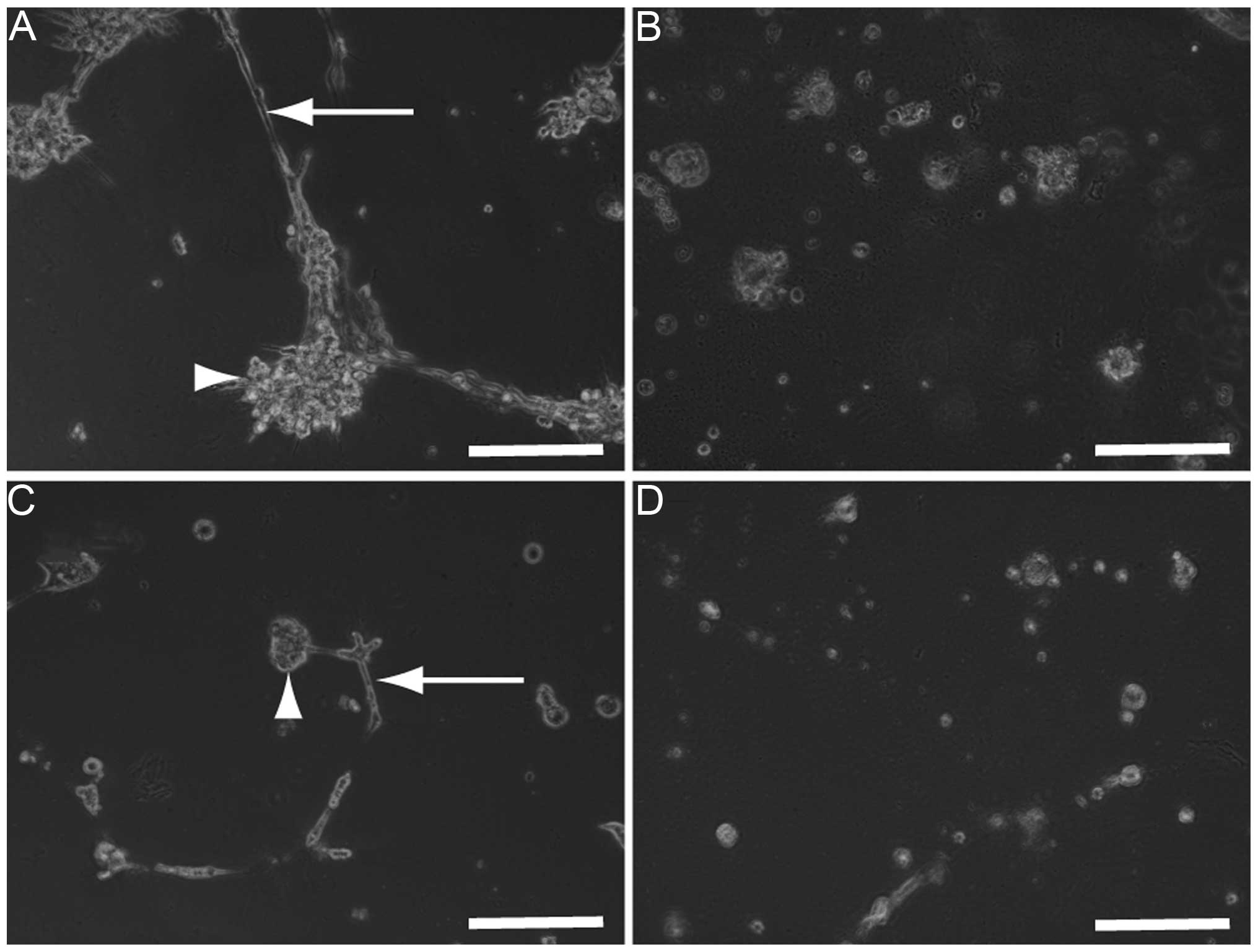 |
Figure 6
|
View References
|
1
|
Lencioni R, Petruzzi P and Crocetti L:
Chemoembolization of hepatocellular carcinoma. Semin Intervent
Radiol. 30:3–11. 2013. View Article : Google Scholar
|
|
2
|
Kim HY and Park JW: Clinical trials of
combined molecular targeted therapy and locoregional therapy in
hepatocellular carcinoma: past, present, and future. Liver Cancer.
3:9–17. 2014. View Article : Google Scholar : PubMed/NCBI
|
|
3
|
Tomizawa M, Kondo F and Kondo Y: Growth
patterns and interstitial invasion of small hepatocellular
carcinoma. Pathol Int. 45:352–358. 1995. View Article : Google Scholar : PubMed/NCBI
|
|
4
|
Miyahara K, Nouso K, Morimoto Y, et al:
Okayama Liver Cancer Group: Pro-angiogenic cytokines for prediction
of outcomes in patients with advanced hepatocellular carcinoma. Br
J Cancer. 109:2072–2078. 2013. View Article : Google Scholar : PubMed/NCBI
|
|
5
|
Xie B, Wang DH and Spechler SJ: Sorafenib
for treatment of hepatocellular carcinoma: a systematic review. Dig
Dis Sci. 57:1122–1129. 2012. View Article : Google Scholar : PubMed/NCBI
|
|
6
|
Furuse J, Ishii H, Nakachi K, Suzuki E,
Shimizu S and Nakajima K: Phase I study of sorafenib in Japanese
patients with hepatocellular carcinoma. Cancer Sci. 99:159–165.
2008.PubMed/NCBI
|
|
7
|
Hu H, Duan Z, Long X, et al: Sorafenib
combined with transarterial chemoembolization versus transarterial
chemoembolization alone for advanced-stage hepatocellular
carcinoma: a propensity score matching study. PLoS One.
9:e966202014. View Article : Google Scholar
|
|
8
|
Nishikawa H, Takeda H, Tsuchiya K, et al:
Japanese Red Cross Liver Study Group: Sorafenib therapy for BCLC
stage B/C hepatocellular carcinoma; clinical outcome and safety in
aged patients: a multicenter study in Japan. J Cancer. 5:499–509.
2014. View
Article : Google Scholar
|
|
9
|
Organ SL and Tsao MS: An overview of the
c-MET signaling pathway. Ther Adv Med Oncol. 3(Suppl 1): S7–S19.
2011. View Article : Google Scholar : PubMed/NCBI
|
|
10
|
Grigioni WF, Fiorentino M, D’Errico A, et
al: Overexpression of c-met protooncogene product and raised Ki67
index in hepatocellular carcinomas with respect to benign liver
conditions. Hepatology. 21:1543–1546. 1995.PubMed/NCBI
|
|
11
|
Kang GH, Lee BS, Lee ES, Kim SH, Lee HY
and Kang DY: Prognostic significance of p53, mTOR, c-Met, IGF-1R,
and HSP70 overexpression after the resection of hepatocellular
carcinoma. Gut Liver. 8:79–87. 2014. View Article : Google Scholar : PubMed/NCBI
|
|
12
|
Scagliotti GV, Novello S and von Pawel J:
The emerging role of MET/HGF inhibitors in oncology. Cancer Treat
Rev. 39:793–801. 2013. View Article : Google Scholar : PubMed/NCBI
|
|
13
|
Mughal A, Aslam HM, Sheikh A, Khan AM and
Saleem S: c-Met inhibitors. Infect Agent Cancer. 8:132013.
View Article : Google Scholar
|
|
14
|
Inagaki Y, Qi F, Gao J, et al: Effect of
c-Met inhibitor SU11274 on hepatocellular carcinoma cell growth.
Biosci Trends. 5:52–56. 2011. View Article : Google Scholar : PubMed/NCBI
|
|
15
|
Dang Y, Luo D, Rong M and Chen G:
Underexpression of miR-34a in hepatocellular carcinoma and its
contribution towards enhancement of proliferating inhibitory
effects of agents targeting c-MET. PLoS One. 8:e610542013.
View Article : Google Scholar : PubMed/NCBI
|
|
16
|
Tomizawa M, Shinozaki F, Sugiyama T,
Yamamoto S, Sueishi M and Yoshida T: Insulin-like growth factor I
receptor involvement in proliferation of NOR-P1 cells in serum-free
media. J Cell Biochem. 113:2714–2720. 2012. View Article : Google Scholar : PubMed/NCBI
|
|
17
|
Tomizawa M, Shinozaki F, Motoyoshi Y, et
al: Niclosamide suppresses hepatoma cell proliferation via the Wnt
pathway. Onco Targets Ther. 6:1685–1693. 2013. View Article : Google Scholar : PubMed/NCBI
|
|
18
|
Harrington LS, Sainson RC, Williams CK, et
al: Regulation of multiple angiogenic pathways by DII4 and Notch in
human umbilical vein endothelial cells. Microvasc Res. 75:144–154.
2008. View Article : Google Scholar : PubMed/NCBI
|
|
19
|
Hu SY, Duan HF, Li QF, et al: Hepatocyte
growth factor protects endothelial cells against gamma ray
irradiation-induced damage. Acta Pharmacol Sin. 30:1415–1420. 2009.
View Article : Google Scholar : PubMed/NCBI
|















